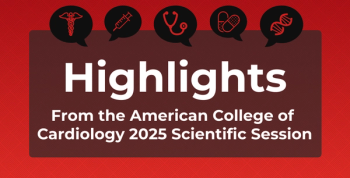
Statin Therapy for LDL Reduction and CV Risk
Matthew J. Budoff, MD, comments on the role of statin therapy for dyslipidemia and shares considerations for appropriate selection and use.
Transcript
Deepak L. Bhatt, MD, MPH: I’m glad you brought in all that, because lifestyle modification is critically important. But there are multiple things that can be done. You mentioned some of the newer diabetes drugs—SGLT2 inhibitors, GLP1 receptor agonists—that have really made an enormous impact on reducing cardiovascular risk among people with diabetes, and the antithrombotics as well. I’m glad you mentioned it as well, because these are really complementary approaches to correcting dyslipidemia.
Speaking of correcting dyslipidemia, let’s say we’ve got a patient for whom we’re doing all the right things in terms of recommendations regarding lifestyle modification, weight reduction, exercise. We have the patient adhering to all those recommendations. Good blood pressure—lowering therapy is implemented, smoking cessation, good diabetes control, and so forth. What about dyslipidemia, specifically? Let me turn to Dr Budoff to discuss the role of statins in reducing that associated cardiovascular risk from elevated levels of LDL [low-density lipoprotein]. Describe what the mechanisms of action are. How do you pick between statins, dose, intensity, etc? Finally, comment on the potential adverse effects and concerns around those.
Matthew J. Budoff, MD: Thank you very much. I just want to reemphasize what Dr Anne Marie Navar touched on. We have to start with lifestyle and incorporate that. We’re often quick to prescribe a therapy without appropriate background treatment. Statins have obviously become our cornerstone of therapy for coronary artery disease prevention as well as secondary treatment. And really, statins have been demonstrated to work in almost every possible scenario.
Earlier, Dr Navar talked about all the different scenarios we could see—everything from primary prevention all the way up to acute coronary syndrome and even polyvascular disease, where more than 1 bed of vascular compromise is present. And really, statins have been proven across all those. Statins are potent event reducers. They lower LDL based on all different doses, but we really get anywhere from about an 18% LDL reduction all the way up to almost a 50% LDL reduction on average, going from the mildest of statins all the way to the highest doses of the most potent statins. So we can really effectively reduce LDL. And what we’ve seen in clinical trials is that LDL reduction parallels with event reduction. As we get larger numbers of LDL drop in our patients, we see larger reductions in cardiovascular risk.
I don’t want to go into all the trials, but 1 study in particular is important when we think about how we can further lower risk, and that’s when we look at trials like the Treating to New Targets trial, which is a study that looked at
We’ve seen a proportional event reduction based on LDL lowering. We’ve seen a consistent benefit. Certainly, those at higher risk have the greatest benefit. The patients who derive the greatest benefit are those patients who are at the highest risk. So those with acute coronary syndrome and patients with vascular disease and multiple events are going to derive even more of that event reduction from statin therapy.
When we talk about how it works, it’s important to remember that HMG-CoA reductase is the rate-controlling enzyme for the mevalonate pathway. I’m not going to go into any biochemistry here, but that really is the rate-controlling step for cholesterol synthesis.
In the liver we stop LDL synthesis. When I talk to my patients, when I explain that they tried weight reduction and they’ve hopefully been compliant with exercise and other therapies and now their LDL is still high, they’re often perplexed because they have changed their diet and are not doing the things that got them into trouble and their LDL level is still too high. I remind them that their liver produces most of the cholesterol. If they’re genetically predisposed to produce too much cholesterol, they’re going to need some help in blocking that mechanism. So we implement statin therapy.
When we think about what dose or how to implement therapy, I simply look at their current LDL and at least what I would perceive to be their target LDL. While I’m a firm believer in lower is better—I know we’re going to get into targets a bit later—we have to think about going straight to more aggressive statins sometimes when we have a high-risk patient with a high LDL.
I’m not a big fan of starting at 10 mg of statin next, and then when they fail on that, titrating up to 20 mg, and then titrating up to 40 mg, and then titrating up to 80 mg. It not only takes a long time, but the patient fails at each step along the way. They consider that a therapeutic failure. A lot of times, if they need a larger LDL reduction, I will go to a larger dose. We commonly start with atorvastatin dosed at 80 mg, which is the highest dose of 1 of the most potent statins right out of the gate when patients come in with acute coronary syndromes or patients come in with severe coronary disease and need to be more aggressively managed.
I think that’s really important. To balance all the treatments we have to remember the adverse effects. The adage is, you can’t make an asymptomatic person feel better, at least not with our traditional cardiac medications. But it’s important to remember that we can make them feel worse. We do get myalgias resulting from statin therapy. It’s seen in maybe 10% of our patients, maybe more depending on what study you cite and what your personal experience is or maybe even where you live. We end up with more statin-induced myalgias here in Southern California, where people want reasons not to do it and to do things in more holistic way. The bottom line is that when patients get myalgias, they often are dose related. The first thing I would do if I had them on a higher dose of a statin is to try to decrease the dose a little. Obviously you lose potency, but you also hopefully decrease the incidence of myalgias. If that doesn’t work, I look at other therapeutic options. There are classes of statins. Some are more water soluble and some are more liquid soluble. We can try a water-soluble statin like pravastatin or rosuvastatin. Pravastatin is better tolerated by some. If that doesn’t work, then go to every-other-day rosuvastatin. I realize that’s an off-label use, but it seems to help some patients by spacing out the therapy. Each time you go down in potency or down to a less potent statin, you do lose some LDL effect, and that might impact their overall risk.
Deepak L. Bhatt, MD, MPH: There are really a lot of useful pearls that you threw in there. I found the same thing with the every-other-day rosuvastatin. It is often well tolerated, even in people who have had myalgias with multiple other regimens. There’s pitavastatin as well. Some people have found that if all other statins are causing problems, sometimes trying something different can do the trick.
Newsletter
Stay ahead of policy, cost, and value—subscribe to AJMC for expert insights at the intersection of clinical care and health economics.









































